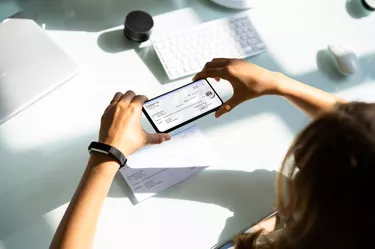
A bank's branch number can designate the branch at which you opened your checking account, or it might identify your bank's home branch. Finding it on a check can be very easy or a bit of a challenge, depending on the financial institution, but you have some options. Many banks print them on their checks but others don't – at least not without a bit of camouflage.
Why Would You Need a Branch Number?
Video of the Day
You might find yourself in the position of having to track down your bank's branch number or the branch number for your credit union if you want to set up a direct deposit of funds to your bank account, such as your paychecks. Along with all the other numbers on your check, it will ensure that your money goes to the correct bank and the right account.
Video of the Day
You might also need a bank's branch number if you want to make a wire transfer or electronically make bill payments from your checking account if your bank offers online banking. Many major businesses like utility companies already have their own branch numbers embedded in their website's payment tabs, but you'll most likely have to provide one for your own bank, too, particularly for automatic, recurring payments.
Look at the Top of Your Check
You can find a bank's branch number very easily in a perfect world. Some banks print it right at the top right-hand corner of the check beneath the check number in the upper right corner.
But the use of this number is becoming less common because it's redundant. It's also incorporated into your bank's routing number, and it's sometimes referred to as a "fractional" bank number for this reason: It's part of a longer, more involved number. Not all banks include it on the top right corner of their checks anymore.
Check the Bottom of Your Checks
Bank routing numbers, sometimes called transit numbers or ABA numbers, were created by the American Bankers Association in 1910 to identify exactly what bank is responsible and liable for paying a check. Only state- and federal-chartered banking institutions are eligible to be assigned one because they must maintain an account with the Federal Reserve Bank.
The account information can be located at the bottom of the check, usually on the left side. It's typically followed by the account number, then by the check number. It's nine digits for U.S. banks, and some of these digits can denote the branch where the bank account was opened and is held – the branch number. You can set up direct deposit or electronic payments using the routing number and your account number.
Some larger banks may have multiple routing numbers, differing by a digit or two, to denote not only the bank but also the location of the branch at which the account is held.
You Have Other Options
Given that the transfer of money is involved here, you might not feel entirely comfortable plucking numbers off the front of a check and trusting that you got them right. You have other options if you want to be absolutely sure of a bank's branch number.
The Federal Deposit Insurance Corporation, more commonly known as the Member FDIC, provides BankFind Suite, a search tool on its website. You can use it to identify the bank you're looking for, then reach out to them to pin down and be sure of any information you need, including branch numbers. The American Bankers Association offers a similar tool on its website that will lead you to a bank's routing number.
You can check your bank statement or go to your bank's website or banking mobile app to pin down the number if you're looking for the one that's applicable to your own account.
If You Make a Mistake
It's always advisable to check with the financial institution in question if only to confirm that you have the number right. While routing numbers typically appear at the left bottom corner of a check, some banks change up the order and might place the bank account number first at the left side, followed by the routing number – and by extension, the branch number. And you'll want to contact the bank right away to put a stop or hold on the transaction if you have reason to think that you made a mistake.